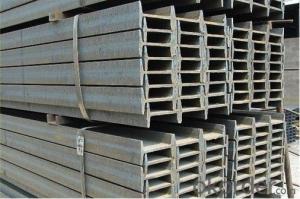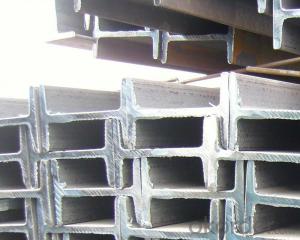Hot Rolled IPE and IPEAA Beam in Q235B Grade
- Loading Port:
- Tianjin
- Payment Terms:
- TT OR LC
- Min Order Qty:
- 25 m.t.
- Supply Capability:
- 10000 m.t./month
OKorder Service Pledge
OKorder Financial Service
You Might Also Like
Product Description:
OKorder is offering high quality Hot Rolled Steel I-Beams at great prices with worldwide shipping. Our supplier is a world-class manufacturer of steel, with our products utilized the world over. OKorder annually supplies products to European, North American and Asian markets. We provide quotations within 24 hours of receiving an inquiry and guarantee competitive prices.
Product Applications:
Hot Rolled Steel I-Beams are ideal for structural applications and are widely used in the construction of buildings and bridges, and the manufacturing, petrochemical, and transportation industries.
Product Advantages:
OKorder's Steel I-Beams are durable, strong, and resist corrosion.
Main Product Features:
· Premium quality
· Prompt delivery & seaworthy packing (30 days after receiving deposit)
· Corrosion resistance
· Can be recycled and reused
· Mill test certification
· Professional Service
· Competitive pricing
Product Specifications:
Manufacture: Hot rolled
Grade: Q195 – 235
Certificates: ISO, SGS, BV, CIQ
Length: 6m – 12m, as per customer request
Packaging: Export packing, nude packing, bundled
Chinese Standard (H*W*T) | Weight (Kg/m) | 6m (pcs/ton) | Light I (H*W*T) | Weight (Kg/m) | 6m (pcs/ton) | Light II (H*W*T) | Weight (Kg/m) | 6M |
100*68*4.5 | 11.261 | 14.8 | 100*66*4.3 | 10.13 | 16.4 | 100*64*4 | 8.45 | 19.7 |
120*74*5.0 | 13.987 | 11.9 | 120*72*4.8 | 12.59 | 13.2 | 120*70*4.5 | 10.49 | 15.8 |
140*80*5.5 | 16.89 | 9.8 | 140*78*5.3 | 15.2 | 10.9 | 140*76*5 | 12.67 | 13.1 |
160*88*6 | 20.513 | 8.1 | 160*86*5.8 | 18.46 | 9 | 160*84*5.5 | 15.38 | 10.8 |
180*94*6.5 | 24.143 | 6.9 | 180*92*6.3 | 21.73 | 7.6 | 180*90*6 | 18.11 | 9.2 |
200*100*7 | 27.929 | 5.9 | 200*98*6.8 | 25.14 | 6.6 | 200*96*6.5 | 20.95 | 7.9 |
220*110*7.5 | 33.07 | 5 | 220*108*7.3 | 29.76 | 5.6 | 220*106*7 | 24.8 | 6.7 |
250*116*8 | 38.105 | 4.3 | 250*114*7.8 | 34.29 | 4.8 | 250*112*7.5 | 28.58 | 5.8 |
280*122*8.5 | 43.492 | 3.8 | 280*120*8.2 | 39.14 | 4.2 | 280*120*8 | 36.97 | 4.5 |
300*126*9 | 48.084 | 3.4 | 300*124*9.2 | 43.28 | 3.8 | 300*124*8.5 | 40.87 | 4 |
320*130*9.5 | 52.717 | 3.1 | 320*127*9.2 | 48.5 | 3.4 | |||
360*136*10 | 60.037 | 2.7 | 360*132*9.5 | 55.23 | 3 |
FAQ:
Q1: Why buy Materials & Equipment from OKorder.com?
A1: All products offered byOKorder.com are carefully selected from China's most reliable manufacturing enterprises. Through its ISO certifications, OKorder.com adheres to the highest standards and a commitment to supply chain safety and customer satisfaction.
Q2: What makes stainless steel stainless?
A2: Stainless steel must contain at least 10.5 % chromium. It is this element that reacts with the oxygen in the air to form a complex chrome-oxide surface layer that is invisible but strong enough to prevent further oxygen from "staining" (rusting) the surface. Higher levels of chromium and the addition of other alloying elements such as nickel and molybdenum enhance this surface layer and improve the corrosion resistance of the stainless material.
Q3: Can stainless steel rust?
A3: Stainless does not "rust" as you think of regular steel rusting with a red oxide on the surface that flakes off. If you see red rust it is probably due to some iron particles that have contaminated the surface of the stainless steel and it is these iron particles that are rusting. Look at the source of the rusting and see if you can remove it from the surface.
Images:


- Q: Are steel I-beams recyclable?
- Yes, steel I-beams are highly recyclable. Steel is one of the most recycled materials in the world, and I-beams can be easily melted down and repurposed into new steel products. Recycling steel I-beams helps to conserve natural resources, reduce energy consumption, and minimize waste.
- Q: Can steel I-beams be used for airport terminal structures?
- Yes, steel I-beams can be used for airport terminal structures. Steel I-beams are commonly used in construction due to their strength, durability, and ability to support heavy loads. These beams can be used to create the framework of an airport terminal, providing structural support for the building. Additionally, steel I-beams can be easily fabricated, allowing for efficient construction and customization according to the specific design requirements of the terminal. The use of steel I-beams in airport terminal structures ensures the necessary strength and stability to accommodate the large span and height requirements of such buildings, while also allowing for flexibility in design and future expansions.
- Q: Can steel I-beams be used for elevated walkways?
- Yes, steel I-beams can be used for elevated walkways. Steel I-beams are commonly used in construction for their strength and load-bearing capacity. They are designed to support heavy loads, making them suitable for building elevated walkways. Steel I-beams provide structural stability and durability, ensuring the safety of pedestrians using the walkway. Additionally, steel is a versatile material that can be easily fabricated to custom lengths and dimensions, allowing for flexibility in designing walkways to fit specific requirements.
- Q: Can steel I-beams be spliced together?
- Indeed, it is possible to splice steel I-beams. Splicing entails the act of connecting two or more beams from end to end in order to form a lengthier beam. This can be achieved through diverse techniques like welding, bolting, or employing splice plates. Splicing is frequently undertaken in construction endeavors when extended beams are needed to bear greater spans or loads. Nonetheless, it is crucial to adhere to appropriate engineering practices and guidelines while splicing to uphold structural integrity and guarantee safety.
- Q: How do steel I-beams perform in terms of fire safety?
- Steel I-beams perform well in terms of fire safety due to their inherent fire-resistant properties. Steel has a high melting point, which makes it less susceptible to structural failure during a fire. Additionally, steel I-beams do not contribute to the spread of fire as they do not burn or release toxic gases. However, prolonged exposure to high temperatures can weaken steel, so proper fire protection measures such as fire-resistant coatings or insulation are necessary to maintain their structural integrity in a fire.
- Q: Can steel I-beams be used in curved structures?
- Yes, steel I-beams can be used in curved structures. While I-beams are typically used in straight applications, they can also be curved to fit the design requirements of a curved structure. This process involves a technique known as cold-bending, where the I-beam is gradually curved to the desired shape using specialized machinery. Cold-bending allows the steel I-beams to be formed into various radii and curves, making them suitable for use in curved structures such as arches, domes, and curved roofs. It is important to note that the bending process may cause some deformation or distortion in the I-beam's cross-section, but this can be mitigated by using proper techniques and ensuring the structural integrity of the curved steel I-beams.
- Q: How do steel I-beams contribute to sustainable building practices?
- There are several ways in which steel I-beams contribute to sustainable building practices. Firstly, steel is an extremely sustainable building material. It can be recycled completely, which means that any steel used in construction can be easily and efficiently repurposed at the end of a building's life cycle. This reduces the need for new raw materials and results in less waste. Secondly, steel I-beams are highly durable and long-lasting. They have a high strength-to-weight ratio, which means that they can support heavy loads without adding excessive weight to the structure. This durability reduces the need for frequent repairs or replacements, resulting in lower maintenance costs and less waste over time. In addition, steel I-beams can be prefabricated off-site and then transported to the construction site. This process requires less energy and resources compared to on-site fabrication, which reduces the carbon footprint of the building project. Moreover, the use of prefabricated steel components can significantly decrease construction time, leading to less disruption to the surrounding environment and a more efficient use of resources. Furthermore, steel I-beams can be designed to maximize energy efficiency in buildings. They can support the integration of insulation materials, which allows for better thermal performance and reduces the need for excessive heating or cooling. Additionally, steel can be combined with other sustainable building systems, such as renewable energy technologies or green roofs, to further enhance the overall sustainability of the building. Lastly, steel I-beams are resistant to fire, pests, and extreme weather conditions, making them a reliable choice for sustainable construction. The longevity of steel structures reduces the need for frequent rebuilding, saving resources and minimizing the environmental impact of the construction industry. In conclusion, steel I-beams contribute to sustainable building practices through their recyclability, durability, energy efficiency, and resistance to various hazards. Their use in construction promotes resource conservation, reduces waste, and helps create environmentally friendly buildings that can last for generations.
- Q: Can steel I-beams be used for industrial manufacturing facilities?
- Yes, steel I-beams are commonly used in industrial manufacturing facilities for their strength, durability, and versatility. Steel I-beams are capable of supporting heavy loads and are often used as structural supports in factories and warehouses. They provide stability and can withstand the demanding conditions typically found in industrial environments, such as high temperatures, heavy machinery, and constant vibrations. Additionally, steel I-beams can be easily fabricated, allowing for efficient customization and assembly in various manufacturing layouts.
- Q: What are the common methods of reinforcing steel I-beams for increased load capacity?
- Common methods of reinforcing steel I-beams for increased load capacity include adding additional steel plates or angles to the flanges or web of the beam, using steel channels or angles to create a composite beam, and installing steel stiffeners or braces to enhance the overall strength and stiffness of the beam. Additionally, strengthening techniques such as post-tensioning or external bonding of carbon fiber reinforced polymer (CFRP) wraps can also be employed to increase the load-carrying capacity of steel I-beams.
- Q: What does welded I-beam I400*1200*12*20 mean?
- The width of 400mm, height 1200mm, web thickness 12mm, the thickness of flange 20mm.Generally expressed as: height H * width B * web thickness t1 * wing plate thickness T2
Send your message to us
Hot Rolled IPE and IPEAA Beam in Q235B Grade
- Loading Port:
- Tianjin
- Payment Terms:
- TT OR LC
- Min Order Qty:
- 25 m.t.
- Supply Capability:
- 10000 m.t./month
OKorder Service Pledge
OKorder Financial Service
Similar products
Hot products
Hot Searches

























